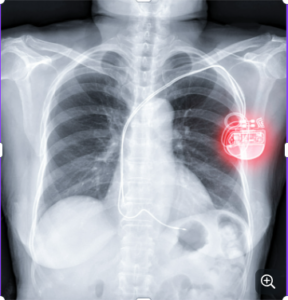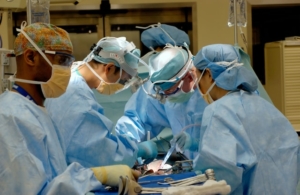
Alex, 66, looked peaceful as he lay on the operation table at a Hospital in India and Mako a surgical robot, went into action. He had a stage-4 arthritis in both knees and had been confined to his home for many months. He finally decided to undergo a knee replacement surgery hoping to relieve pain and reclaim his social life.
With its long, slender fingers and superb surgical skills. Mako stole the show at the operation theater. Be it creating a 3D model of Alex’s joint based on CT scan reports, creating boundaries, removing bits of patient knee or making precise bone cuts. Mako leaves one wondering about the blurring lines between robots and humans.
Once the surgery was done the jubilant team of Surgeons at Hospital collectively said, “Thank you Mako!” I looked up to see whether Mako smiled or bowed it head. Doctors and Chief of Orthopedic surgeon at the hospital told that Mako cannot smile back. Not yet! But it can put a smile on the patient’s face. “The pain is less and the recovery is faster. Even infection rate is less,” says Doctor.
Around 75% of the knee replacement patients opt for robotic surgery. Mako comes handy in hip replacement s as well. “How much of bone should be cut is decided by the robot, based on our capture of anatomy and CT scan reports. This help surgeons plan the surgery better and calculate the size of the implant accurately. Doctors have never had to change the implant size,” says Doctor.
Surgical robots have been the game changers. They are now being used in brain, spine, lung and heart surgeries. “Now we have robots not just for doing regular surgeries like knee and hip replacements, but also for abdominal surgeries that includes genecology, urology, colorectal and prostate surgeries” says Doctors at Hospitals in India. The robots are becoming more user friendly and more acceptable to patients.
Katy from Europe would vouch for surgical robots. The 46 year old had abnormal bleeding, was diagnosed with uterine cancer and underwent a robotic surgery at Cancer Hospital. “Her uterine cancer was thoroughly excised, with minimal impact on surrounding health tissues,” says Doctor a Gynecologic oncologist and robotic surgery expert at the center. Katy’s husband, Neil says his wife’s post operative pain was much less and recovery faster because of the robotic surgery.
Better than humans
Robots are better surgeons than human in many ways. Robotic wrists rotate 360 degrees. Using the joystick, the surgeon can curve the scissor upside down. It enhances the precision and causes less bleeding and damage to surrounding tissues. It also gives surgeons more control. The camera that goes in gives 3D view, allowing the surgeon to see the internal organs clearly. The camera also gives a magnified view of the area to be operated on.
At an operation theater in India. Jatin Prakash a 46 year old patient is about to be operated on. Prakash was diagnosed with a Kidney tumour following a health check up.
Doctors draws attention to a 3D monitor that shows a small blood vessel that’s going into the patient’s kidney. Consultant in Urology robotic surgery and renal transplantation takes special care to preserve the vessel. “Since there is no bleeding, people recover faster, and they experience less pain. Within a week or ten days, they are back to work. Traditional methods would require the patient to take rest for a month,” Doctor says.
Doctors and surgeons currently use fifth generation Da-Vinci robotic system. Da Vinci is a great tool for surgeons for operations on the heart, lungs, food pipe, chest and other organs deep inside the body.
ROBOT PARTS
THE DA VINCI SURGICAL SYSTEM HAS THREE PARTS.
1 A surgical robot that has four arms controlled by the surgeon.
2. A cart with an external monitor that is connected to a camera and the body of the patient. The surgeon can see images of the body part being operated on the monitor. there is a light source which takes the light inside.
3 A console where the surgeon sits. The surgeon controls the robot using two joysticks on the console. The surgeons movement are transmitted to the arms of the robot. the pedals on the console control the instruments that go into the patient’s body including the scissor and staplers which cut and seal the tissue.
Can robots use their discretion and perform surgeries on their own? Currently, robots are operated and controlled by surgeons. In the future, we may have robots that are more self-reliant and autonomous. Every time a robotic surgery is performed, the data is stored in the cloud. Once enough data is available, experts say artificial intelligence (AI) could be applied on it for robots to act autonomously.
Doctors finds it exciting that even a young surgeon can now produce results as good as those of senior surgeons with the help of surgical robots. Senior surgeons also have reasons to rejoice. “As you age, your diagnostic skills and ability to resolve a problem get better. A surgeon is at his or her peak arounf 55, as far as motor skills are concerned. Says a senior doctor. But then the journey downhill starts. “With robots, you can go no for much longer, because they take away the need for great motor skills.”
MORE EXPENSIVE
BUT MAYBE WORTH IT
Robotic surgery tends to be more expensive than conventional surgery, but the outcomes are better and so the additional cost often seems justifiable for patients. ” A robotic surgery cost about 5000 USD in ENT specialty. if we compare cost to cost and hospital stay for conventional surgery, the difference may be in the range of 1000 to 1200 USD.
CONTACT US FOR YOUR MEDICAL TREATMENT
CALL OR WHATSAPP AT +91 81006 28482




